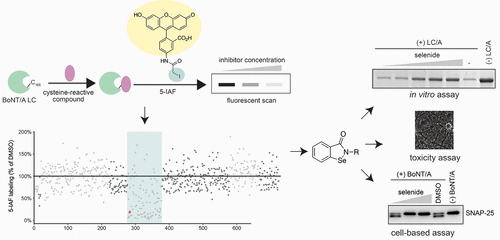当前位置:
X-MOL 学术
›
ACS Chem. Biol.
›
论文详情
Our official English website, www.x-mol.net, welcomes your
feedback! (Note: you will need to create a separate account there.)
Covalent Modifiers of Botulinum Neurotoxin Counteract Toxin Persistence.
ACS Chemical Biology ( IF 3.5 ) Pub Date : 2019-01-08 , DOI: 10.1021/acschembio.8b00937 Megan Garland 1 , Brett M Babin , Shin-Ichiro Miyashita 2 , Sebastian Loscher , Yi Shen 2 , Min Dong 2 , Matthew Bogyo
ACS Chemical Biology ( IF 3.5 ) Pub Date : 2019-01-08 , DOI: 10.1021/acschembio.8b00937 Megan Garland 1 , Brett M Babin , Shin-Ichiro Miyashita 2 , Sebastian Loscher , Yi Shen 2 , Min Dong 2 , Matthew Bogyo
Affiliation

|
Botulinum neurotoxins (BoNTs) are the most potent toxins known to man and a significant threat as weapons of bioterrorism. BoNTs contain a metalloprotease domain that blocks neurotransmitter release in nerve terminals, resulting in a descending, flaccid paralysis with a 5-10% mortality rate. Existing treatment options cannot access or neutralize the toxin following its endocytosis, so there is a clear need to develop novel therapies. Numerous substrate-based and zinc-chelating small-molecule inhibitors have been reported; however, none have progressed to the clinic. This is likely due to the difficulty that reversible inhibitors have in achieving sustained inhibition of the toxin, which has a half-life of months in vivo. An alternative strategy for mitigating BoNT persistence is covalent, irreversible inhibition of toxin function. However, few examples of covalent BoNT inhibitors have been reported. Here, we describe a competition-based screen to identify covalent modifiers of the conserved active-site-adjacent cysteine C165 in the BoNT/A serotype. We found that compounds containing cysteine-reactive electrophiles designed to target cysteine proteases failed to bind C165 while selenide compounds were efficient covalent binders of this cysteine. Importantly, covalent modification at C165 resulted in sustained, irreversible inhibition of BoNT/A protease activity. Covalent selenide inhibitors were nontoxic and protective in a neuronal assay of intoxication, making them promising new scaffolds for the study of the BoNT/A toxin as well as for the design of novel therapy agents.
中文翻译:

肉毒杆菌神经毒素的共价修饰剂可抵消毒素的持久性。
肉毒杆菌神经毒素(BoNT)是人类已知的最有效毒素,是生物恐怖主义的重要威胁。BoNTs含有一个金属蛋白酶结构域,该结构域阻止神经递质在神经末梢的释放,从而导致下降的,松弛的瘫痪,死亡率为5-10%。现有的治疗选择无法在毒素胞吞后获得或中和毒素,因此显然需要开发新的疗法。已经报道了许多基于底物和锌螯合的小分子抑制剂。但是,都没有进展到诊所。这可能是由于可逆抑制剂难以实现毒素的持续抑制,而该毒素在体内的半衰期为数月。缓解BoNT持久性的另一种策略是共价,不可逆地抑制毒素功能。然而,共价BoNT抑制剂的报道很少。在这里,我们描述了一种基于竞争的筛选,以鉴定BoNT / A血清型中保守的活性位点附近的半胱氨酸C165的共价修饰因子。我们发现,含有设计为靶向半胱氨酸蛋白酶的半胱氨酸反应性亲电试剂的化合物无法结合C165,而硒化物化合物则是该半胱氨酸的有效共价结合剂。重要的是,在C165处的共价修饰导致对BoNT / A蛋白酶活性的持续,不可逆的抑制。共价硒化物抑制剂在中毒的神经元分析中无毒且具有保护性,使其成为有希望用于BoNT / A毒素研究以及新型治疗剂设计的新支架。我们描述了一种基于竞争的筛选,以鉴定BoNT / A血清型中保守的活性位点附近的半胱氨酸C165的共价修饰物。我们发现,含有设计为靶向半胱氨酸蛋白酶的半胱氨酸反应性亲电试剂的化合物无法结合C165,而硒化物化合物则是该半胱氨酸的有效共价结合剂。重要的是,在C165处的共价修饰导致对BoNT / A蛋白酶活性的持续,不可逆的抑制。共价硒化物抑制剂在中毒的神经元分析中无毒且具有保护性,使其成为有希望用于BoNT / A毒素研究以及新型治疗剂设计的新支架。我们描述了一种基于竞争的筛选,以鉴定BoNT / A血清型中保守的活性位点附近的半胱氨酸C165的共价修饰物。我们发现,含有设计为靶向半胱氨酸蛋白酶的半胱氨酸反应性亲电试剂的化合物无法结合C165,而硒化物化合物则是该半胱氨酸的有效共价结合剂。重要的是,在C165处的共价修饰导致对BoNT / A蛋白酶活性的持续,不可逆的抑制。共价硒化物抑制剂在中毒的神经元分析中无毒且具有保护性,使其成为有希望用于BoNT / A毒素研究以及新型治疗剂设计的新支架。我们发现,含有设计为靶向半胱氨酸蛋白酶的半胱氨酸反应性亲电试剂的化合物无法结合C165,而硒化物化合物则是该半胱氨酸的有效共价结合剂。重要的是,在C165处的共价修饰导致对BoNT / A蛋白酶活性的持续,不可逆的抑制。共价硒化物抑制剂在中毒的神经元分析中无毒且具有保护性,使其成为有希望用于BoNT / A毒素研究以及新型治疗剂设计的新支架。我们发现,含有设计为靶向半胱氨酸蛋白酶的半胱氨酸反应性亲电试剂的化合物无法结合C165,而硒化物化合物则是该半胱氨酸的有效共价结合剂。重要的是,在C165处的共价修饰导致对BoNT / A蛋白酶活性的持续,不可逆的抑制。共价硒化物抑制剂在中毒的神经元分析中无毒且具有保护性,使其成为有希望用于BoNT / A毒素研究以及新型治疗剂设计的新支架。
更新日期:2018-12-20
中文翻译:

肉毒杆菌神经毒素的共价修饰剂可抵消毒素的持久性。
肉毒杆菌神经毒素(BoNT)是人类已知的最有效毒素,是生物恐怖主义的重要威胁。BoNTs含有一个金属蛋白酶结构域,该结构域阻止神经递质在神经末梢的释放,从而导致下降的,松弛的瘫痪,死亡率为5-10%。现有的治疗选择无法在毒素胞吞后获得或中和毒素,因此显然需要开发新的疗法。已经报道了许多基于底物和锌螯合的小分子抑制剂。但是,都没有进展到诊所。这可能是由于可逆抑制剂难以实现毒素的持续抑制,而该毒素在体内的半衰期为数月。缓解BoNT持久性的另一种策略是共价,不可逆地抑制毒素功能。然而,共价BoNT抑制剂的报道很少。在这里,我们描述了一种基于竞争的筛选,以鉴定BoNT / A血清型中保守的活性位点附近的半胱氨酸C165的共价修饰因子。我们发现,含有设计为靶向半胱氨酸蛋白酶的半胱氨酸反应性亲电试剂的化合物无法结合C165,而硒化物化合物则是该半胱氨酸的有效共价结合剂。重要的是,在C165处的共价修饰导致对BoNT / A蛋白酶活性的持续,不可逆的抑制。共价硒化物抑制剂在中毒的神经元分析中无毒且具有保护性,使其成为有希望用于BoNT / A毒素研究以及新型治疗剂设计的新支架。我们描述了一种基于竞争的筛选,以鉴定BoNT / A血清型中保守的活性位点附近的半胱氨酸C165的共价修饰物。我们发现,含有设计为靶向半胱氨酸蛋白酶的半胱氨酸反应性亲电试剂的化合物无法结合C165,而硒化物化合物则是该半胱氨酸的有效共价结合剂。重要的是,在C165处的共价修饰导致对BoNT / A蛋白酶活性的持续,不可逆的抑制。共价硒化物抑制剂在中毒的神经元分析中无毒且具有保护性,使其成为有希望用于BoNT / A毒素研究以及新型治疗剂设计的新支架。我们描述了一种基于竞争的筛选,以鉴定BoNT / A血清型中保守的活性位点附近的半胱氨酸C165的共价修饰物。我们发现,含有设计为靶向半胱氨酸蛋白酶的半胱氨酸反应性亲电试剂的化合物无法结合C165,而硒化物化合物则是该半胱氨酸的有效共价结合剂。重要的是,在C165处的共价修饰导致对BoNT / A蛋白酶活性的持续,不可逆的抑制。共价硒化物抑制剂在中毒的神经元分析中无毒且具有保护性,使其成为有希望用于BoNT / A毒素研究以及新型治疗剂设计的新支架。我们发现,含有设计为靶向半胱氨酸蛋白酶的半胱氨酸反应性亲电试剂的化合物无法结合C165,而硒化物化合物则是该半胱氨酸的有效共价结合剂。重要的是,在C165处的共价修饰导致对BoNT / A蛋白酶活性的持续,不可逆的抑制。共价硒化物抑制剂在中毒的神经元分析中无毒且具有保护性,使其成为有希望用于BoNT / A毒素研究以及新型治疗剂设计的新支架。我们发现,含有设计为靶向半胱氨酸蛋白酶的半胱氨酸反应性亲电试剂的化合物无法结合C165,而硒化物化合物则是该半胱氨酸的有效共价结合剂。重要的是,在C165处的共价修饰导致对BoNT / A蛋白酶活性的持续,不可逆的抑制。共价硒化物抑制剂在中毒的神经元分析中无毒且具有保护性,使其成为有希望用于BoNT / A毒素研究以及新型治疗剂设计的新支架。











































 京公网安备 11010802027423号
京公网安备 11010802027423号